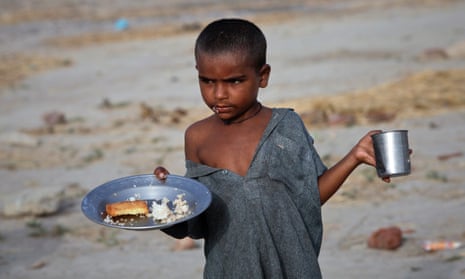If you’re a fan of poverty numbers, the World Bank’s latest global poverty estimates – which came complete with a 66-page document explaining the reasoning behind them – were a case of Christmas come early.
To be considered extremely poor now means living on less than $1.90 (£1.24) a day. On this measure, the number is projected to fall to about 700 million people this year. This is still a large number of people, but fewer than before – poverty has been on an almost continuous downward trajectory since 1990.
Progress hasn’t been even: poverty reduction has been rapid in much of Asia, but sub-Saharan Africa has experienced much slower falls and is now home to the greatest number of extremely poor people in the world.
Half of all poor people live in countries classified either fragile and conflict-affected or natural-resource dependent.
Poverty estimates are exciting if you’re a researcher in Washington, London or Delhi. But the numbers become much less useful when it comes to understanding what needs to be done to end global poverty. The figures offer no detail about what is happening within countries, which is where the work will have to be done if the world is to meet the recently adopted aspiration to end extreme poverty by 2030.
Not everyone is poor in poor countries, and the people who live below the new $1.90 poverty line tend to share certain characteristics. In Nigeria, for example, ethnicity and geography are key drivers of the inequalities that sustain extreme poverty. People from ethnic minorities living in rural areas have always been the majority of the extreme poor in that country, and recent Overseas Development Institute research points to stubborn gaps between them and the rest of the population. In a forthcoming report, we outline how less than 1% of the Yoruba are in the poorest fifth of the population, while more than half of the Fulani ethnic group are among the poorest Nigerians.
Patterns of poverty are a product of years of discrimination, and ending poverty among the poorest groups will take something quite different from ending it among the more privileged Nigerians – but the new poverty numbers can’t tell us what. What is needed is not just headlines at the level of countries but much more detailed information on who is poor within countries – in other words, better data.
Most data on the poorest countries is pieced together from surveys, estimates and government figures. Poverty numbers are most commonly based on household surveys run by donors – with the US government, the UN and the World Bank funding the largest programmes. Only a tiny minority of those surveys are big enough, or ask the right questions, to get the kind of information governments need to plan services or design policies for the very poorest people.
In the spirit of the “data revolution” and the new global partnership on data, the US, UN and World Bank recently agreed to work together to help make the data they collect more comparable, and reduce gaps in coverage. This could make things better for governments trying to find out what they need to know about their populations to end poverty – for example, collecting data on ethnicity or disability, or the other factors that make poverty so intractable in many countries.
But who is driving the changes? If investments and improvements in data are driven by international organisations, whose interests are in the big global numbers like those published this week, we could see fewer surveys that offer the information governments need, and more that are driven by the needs of donors and global institutions. There is no reason why we cannot do both, but it all has to be properly designed and paid for. The last thing the data revolution should be about is creating perfect figures to describe poverty, at the expense of information that can help to end it.
